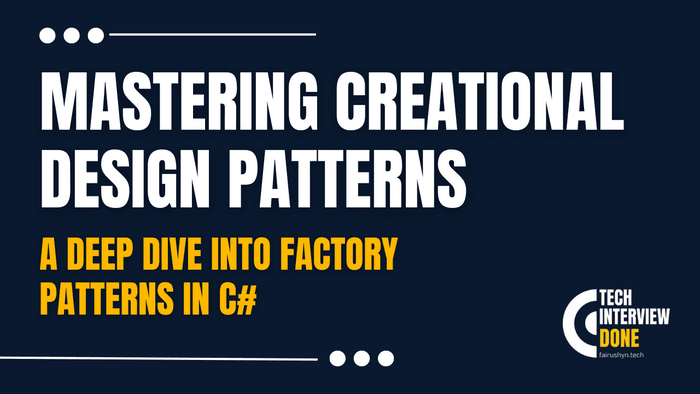A Deep Dive into Factory Patterns in C#/.Net
3 min read · — #design-patterns#creational-patterns#factories
Introduction
Welcome to a comprehensive exploration designed to elevate your understanding and application of Creational Design Patterns in C#, focusing on the Factory Method and Abstract Factory patterns. This guide is crafted for experienced software engineers aiming to refine their design skills further, enhance code maintainability, and excel in technical interviews. By delving into the nuances of these patterns, you'll discover how to solve complex design challenges with elegance and efficiency, making your software architecture more robust and scalable.
Creational design patterns are pivotal in how objects are created in object-oriented programming. They abstract the instantiation process, making systems more independent of how their objects are created, composed, and represented. Among these patterns, the Factory Method and Abstract Factory stand out for their versatility and ability to decouple client code from the concrete classes it needs to instantiate.
Factory Method Pattern
Concept
The Factory Method Pattern defines an interface for creating an object but lets subclasses decide which class to instantiate. It lets a class defer instantiation to subclasses, promoting loose coupling and scalability.
Real-World Scenario
Imagine you're developing a document management system where users can create different types of documents, like text documents, spreadsheets, and presentations. Each document type has its own specific behavior and rendering logic. Applying the Factory Method pattern allows you to define a common interface for creating documents, while letting subclasses determine the type of document instantiated.
Implementation in C#
public abstract class DocumentCreator
{
// The factory method
public abstract Document CreateDocument();
public void SomeOperation()
{
// Create document
Document document = CreateDocument();
document.Render();
}
}
public class TextDocumentCreator : DocumentCreator
{
public override Document CreateDocument() => new TextDocument();
}
public class SpreadsheetDocumentCreator : DocumentCreator
{
public override Document CreateDocument() => new SpreadsheetDocument();
}
public abstract class Document
{
public abstract void Render();
}
public class TextDocument : Document
{
public override void Render()
{
Console.WriteLine("Rendering Text Document");
}
}
public class SpreadsheetDocument : Document
{
public override void Render()
{
Console.WriteLine("Rendering Spreadsheet Document");
}
}Abstract Factory Pattern
Concept
The Abstract Factory Pattern provides an interface for creating families of related or dependent objects without specifying their concrete classes. This pattern is ideal for systems with complex object creation processes and where there is a need to manage or control the creation of these objects.
Real-World Scenario
Consider a UI toolkit for creating cross-platform applications. Your toolkit needs to provide a consistent look and feel across different operating systems (OS), like Windows, macOS, and Linux. Each OS has a different implementation for UI elements such as buttons, text boxes, and windows. The Abstract Factory pattern allows you to define an interface for creating families of related objects (UI elements) without specifying their concrete classes.
Implementation in C#
// Abstract factory
public interface IUIElementFactory
{
IButton CreateButton();
ITextBox CreateTextBox();
}
// Concrete factories
public class WindowsUIElementFactory : IUIElementFactory
{
public IButton CreateButton() => new WindowsButton();
public ITextBox CreateTextBox() => new WindowsTextBox();
}
public class MacOSUIElementFactory : IUIElementFactory
{
public IButton CreateButton() => new MacOSButton();
public ITextBox CreateTextBox() => new MacOSTextBox();
}
// Abstract products
public interface IButton
{
void Render();
}
public interface ITextBox
{
void Render();
}
// Concrete products
public class WindowsButton : IButton
{
public void Render()
{
Console.WriteLine("Rendering Windows Button");
}
}
public class WindowsTextBox : ITextBox
{
public void Render()
{
Console.WriteLine("Rendering Windows TextBox");
}
}
public class MacOSButton : IButton
{
public void Render()
{
Console.WriteLine("Rendering MacOS Button");
}
}
public class MacOSTextBox : ITextBox
{
public void Render()
{
Console.WriteLine("Rendering MacOS TextBox");
}
}In this scenario, IUIElementFactory is the abstract factory interface, with WindowsUIElementFactory
and MacOSUIElementFactory as concrete implementations creating platform-specific UI elements. This pattern
encapsulates the creation logic and promotes a high degree of flexibility and scalability.
Conclusion
Mastering the Factory Method and Abstract Factory patterns in C# enables software engineers to write code that is more maintainable, scalable, and decoupled. By understanding and applying these patterns, you can design systems with a clear separation of concerns, making them easier to extend, modify, and test. As you prepare for your technical interviews, reflecting on these design patterns and considering their implications in real-world applications will undoubtedly set you apart as a proficient and thoughtful engineer.
